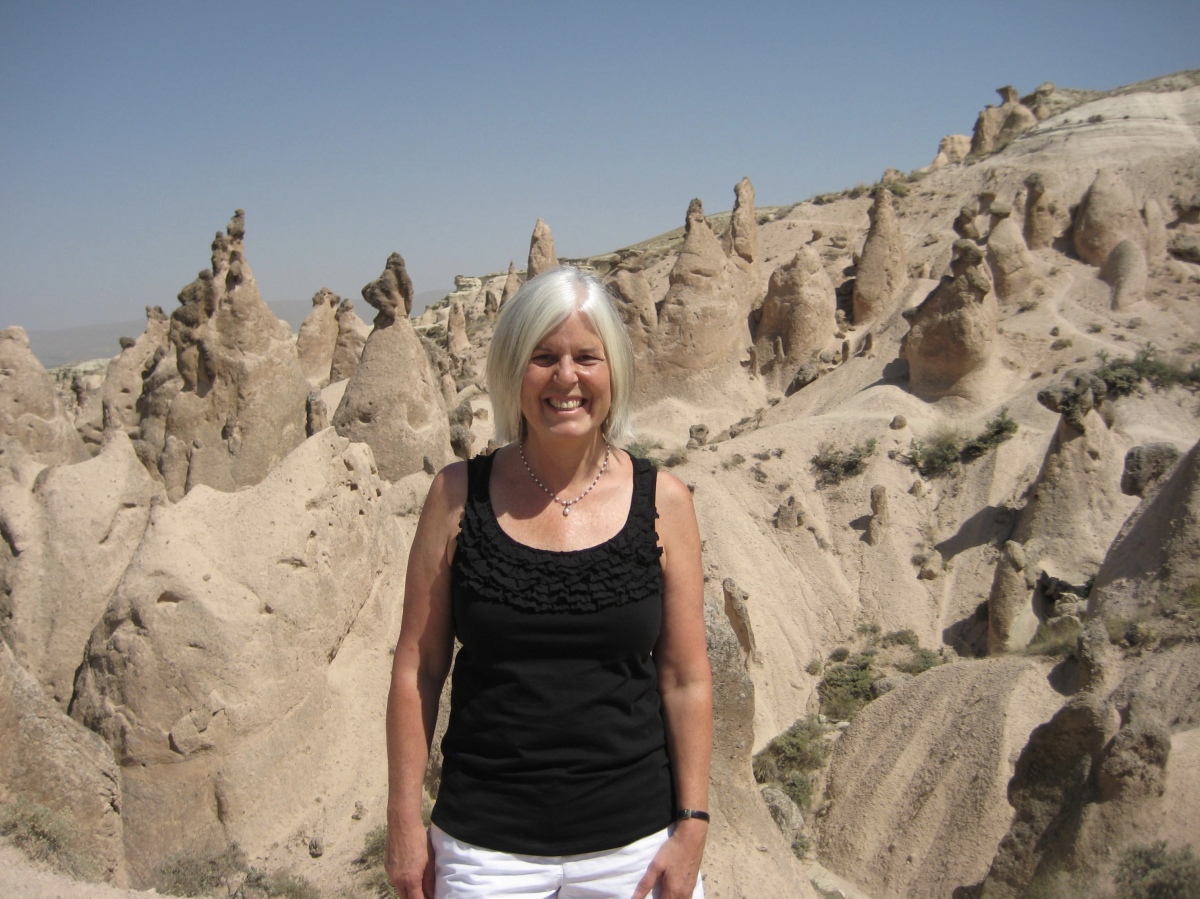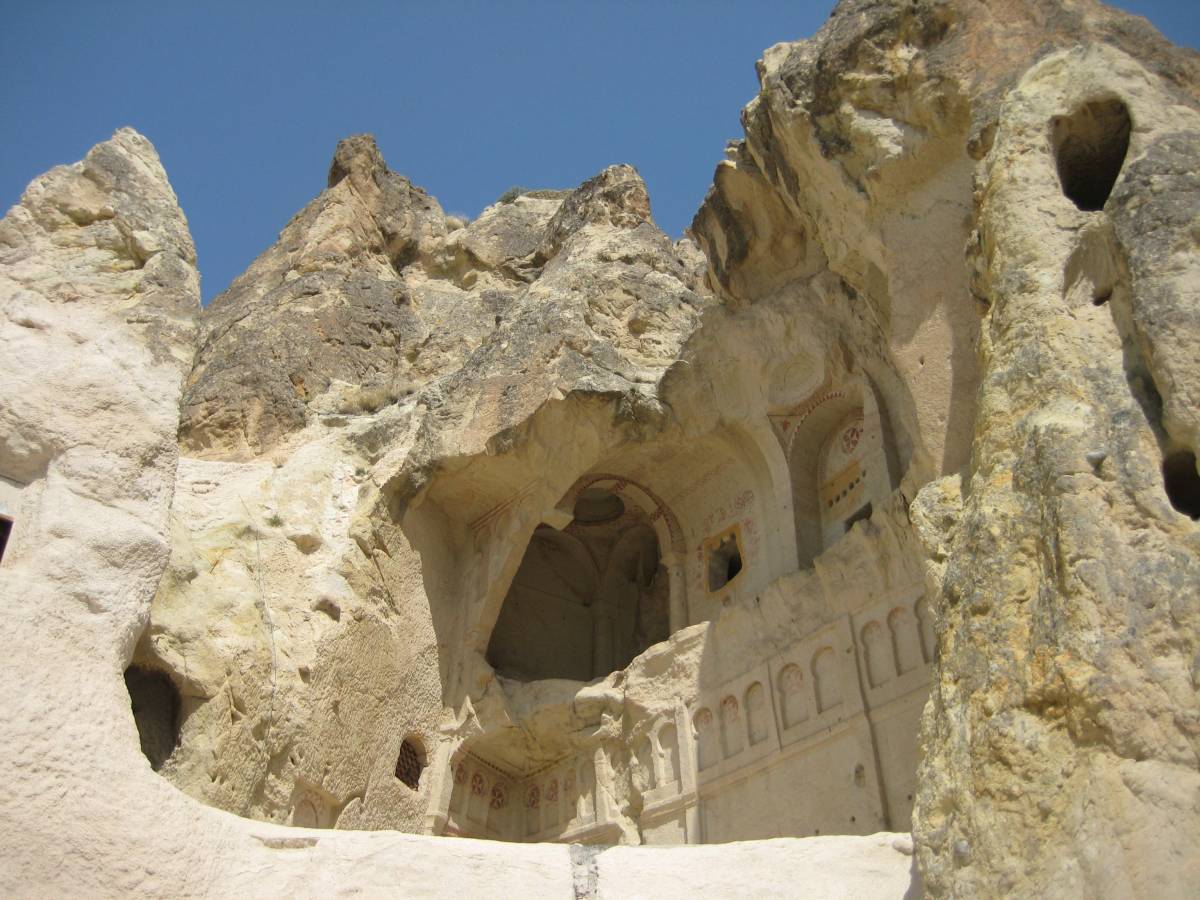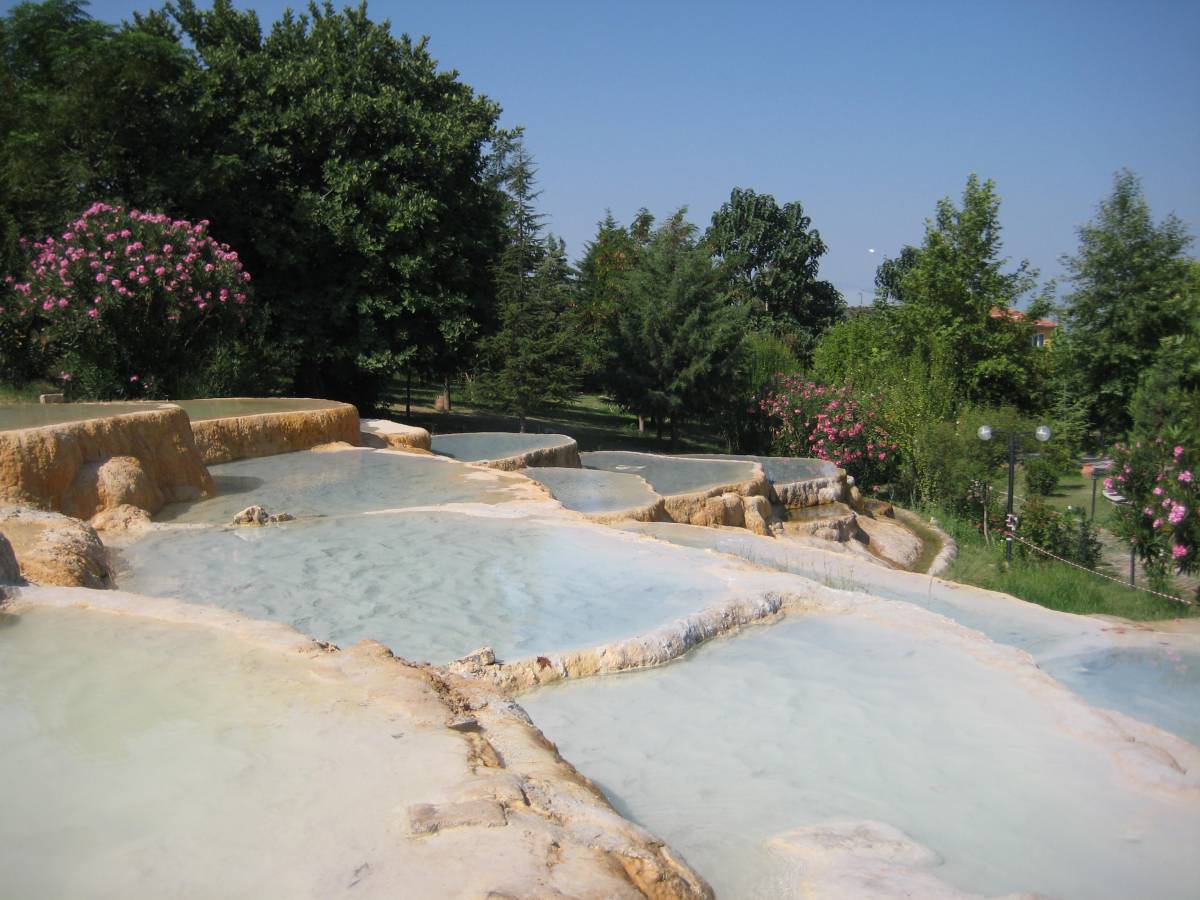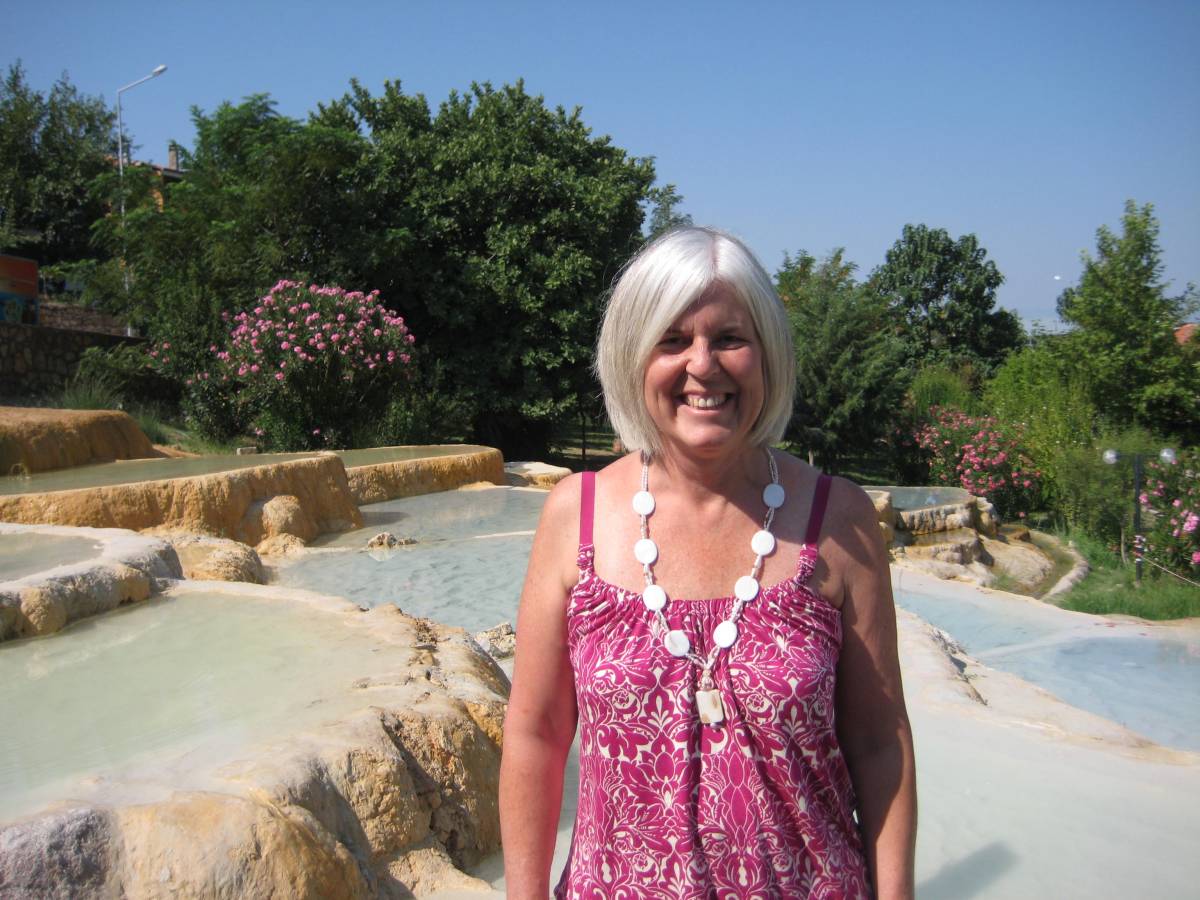Fourteen days in Turkey for my first ever solo trip at age 54. Fourteen days being greeted at the airport and at bus stations with my name on cardboard signs, sleeping in cave hotels and bunking in my first-ever hostel.
Fourteen days wandering around in Istanbul’s Sultanahmet area, mesmerized by the Blue Mosque and Hagia Sophia, their minarets symbolic of man’s hopeful attempts to touch the celestial, to touch God — either Allah or Christ — depending on the century. Admiring elements of the Byzantine and Ottoman empires and their religions, Orthodox Christianity and Islam, in Hagia Sophia; like Istanbul, it embraces both East and West, all tied into one. Falling in love with Turkey’s two-sided Middle Eastern and European personality.
Finding ceramic tiles inside the Blue Mosque to be white with a blue design, mostly 17th century Iznik tiles, not the brilliant blue – royal or turquoise – that I had imagined. Falling in love with non-figurative art in the mosque: geometric designs, calligraphy, painted floral patterns. Learning that Arabic calligraphy is mostly excerpts from the Quran or from the hadith, or the teachings of the Prophet Muhammad.
Fourteen days eating white bean and olive oil salad; meatballs; cold meze; a mix of yogurt, cucumbers, and garlic with olive oil; and appetizers served in small portions: stuffed grape leaves and eggplant salad (delectable!). Drinking red wine and eating lemon chicken orzo soup and a vegetable omelet at Lale Restaurant, the famous “The Pudding Shop,” where, according to Rick Steves, “a generation of vagabond hippies started their long journey east on ‘The Freak Road’ to Kathmandu in the 1960s.” Sinking into stuffed Turkish cushions smoking water pipes in the evenings, watching whirling dervishes and listening to musicians play exotic tunes. Sitting on layered terraces overlooking the town of Ürgüp at the peaceful Dimrit Restaurant, listening to music by Canadian Loreena McKennitt. Choosing cold mushrooms with fresh dill from a tray of starters in moon-shaped bowls, cool and refreshing like the cool moon on a breezy night, like an oasis in a parched desert. Trying rakı, the official Turkish drink, a clear brandy made from grapes and raisins and flavored with anise that turns milky white when mixed with ice or water — similar to Greek ouzo. Learning that Turks often call rakı Lion’s Milk because of its color and strong alcoholic punch. Eating hot puffy bread that resembled a pillow right out of the oven, followed by doner kebabs, at Buhara 93. Eating midye tava, or deep-fried mussels, at Anadolu Kavagi during the Nostalgic Bosphorus Cruise. Smoking apple-flavored tobacco on big fluffy cushion-smothered couches and eating more doner kebabs at Doy Doy with a terrace view of Sultanahmet.
Fourteen days enticed by dazzling things in shop windows: colorful lamps, handbags with Ottoman and Byzantine designs, Turkish carpets, ceramic tiles and plates, pashminas, silk scarves, and scarlet and turquoise lamps.
Fourteen days of ubiquitous royal blue evil eyes staring at me from every dark corner.
Fourteen days exploring exuberant markets full of spices, flowers and vegetables. Wondering about Turkish Viagra, a popular name for a spiced paste in the form of candy (made of nuts and dried fruits) which claims to restore health, youth and potency. Finding in the spice market a feast of sights and aromas: Turkish delight, lentils and beans, dried figs and apricots, pistachios and hazelnuts, saffron, henna, and olive oil soap.
Fourteen days going back in time to antiquity. Wandering around the lovely grounds and admiring the Divan Tower and the Council Chamber at the 15th century Topkapi Palace home to the Ottoman sultans. Finding, in the Harem, that “Harem” refers to 2 things: (1) the wives, favorites and concubines of the sultan, and (2) the place where they lived. Getting lost in dozens of rooms rich with tile-work, including the Courtyard of the Mother Sultan, the Courtyard of the Wives and Concubines, and the Courtyard of the Black Eunuchs. Dropping into the green lush grounds of the Archeological Museum with its ancient statues, and finding, inside, a huge sarcophagi collection. Encountering the 2,000-year-old Alexander Sarcophagus (Alexander the Great is portrayed in battle on the sides), though it was actually carved for King Abdalonymos of Sidon. Meandering among Greek and Roman sculptures.
Fourteen days admiring Mustafa Kemal, whom Turks call Atatürk, literally “father of the Turks.” Learning how he defended Turkey from invaders during WWI and saved Turkey from the chopping block after the war; how he was a war hero and had a vision of what he wanted modern-day Turkey to be; how he wanted a European-style democracy and in less than 10 years, he aligned Turkey with the West, separated religion and state, adopted the Western calendar, decreed that Turks should have surnames, changed the alphabet to Roman letters from Arabic script, abolished the sultanate and caliphate and polygamy, emancipated women and outlawed the fez and the veil. Grieving over his 1938 death, which Turkey observes each year with a moment of silence at 9:05 on November 10 each year.
Fourteen days exploring corners of Istanbul, including the 205-foot-tall stone Galata Tower built by the Genoese in the mid-14th century, and seeing everything from the top: the Bosphorus, the Golden Horn, Hagia Sophia and the Blue Mosque, Asian Istanbul, the Sea of Marmara. Learning it has been used over the years as a fire tower, a barracks, a dungeon, and a launch pad for testing human flight.
Fourteen days crisscrossing Turkey over rough, nearly-deserted roads on the dreaded overnight buses, enjoying sunrise views of central Anatolia: a large expanse of treeless plains, soft dusty-green hills with gentle folds. Peering out the bus window over a huge body of shallow water and mudflats stretching to the horizon.
Fourteen days hiking, picnicking, and ballooning in Cappadocia. Hiking 3km in Soganli Valley among rock-cut churches, first used by the Romans as necropolises and later by the Byzantines for monastic purposes. Finding frescoes of Jesus, the apostles, the Crusaders and snakes, which represent Satan, in the Snake Church. Exploring too many churches and caves and frescoes to count: Sakli Kilise (the Hidden Church), Kubbeli Kilisesi (the Domed Church), Yilanli Kilise (the Snake Church).

Cappadocia
Fourteen days enjoying various people I met, especially the group of international young travelers on our small group tour led by Selim. Ordering an omelet that arrived still bubbling in a small cast iron skillet at an outdoor table at Soganli Cappadocia Restaurant with a group of fun-loving Italian travelers.

Cappadocia

Cappadocia

lunchtime
Fourteen days hiking through Devrent Imagination Valley, where the volcanic rock formations are of such unlikely and distinguished shapes, that you can imagine they are animals: a crocodile, a lizard, Snoopy the comic strip dog, a squirrel, a camel, a bulldog, a dolphin, and other reptiles. Strolling through Fairy Chimneys and the Göreme Open Air Museum, one of Turkey’s World Heritage sites, to see a nearly infinite number of churches, chapels and monasteries mainly from the 11th century, carved in rocks: the Chapel of St. Basil, The Elmali (Apple) Church, The Chapel of St. Barbara, The Chapel of St. Catherine: cruciform shapes, frescoes in red of mythological figures, Christ, Mary, the saints.

Cappadocia

Cappadocia

Cappadocia

me in Cappadocia

Cappadocia

Cappadocia

Cappadocia

Cappadocia

Cappadocia

Cappadocia

Cappadocia

Cappadocia

Cappadocia

Cappadocia
Fourteen days in the lunar landscape of Cappadocia, where, at sunrise, nearly 40 hot air balloons lay everywhere, bellies up, like bloated beached whales painted in rainbow colors. Watching men push the balloons outwards from within as the fires began to roar, blasting and flaming into these balloons, huffing & puffing like dragons. Lifting off in the balloons, the hot air working its magic, rising slowly while the men turned the wicker baskets from their sides to upright positions. Getting lifted into the baskets as there were no doors. Hearing the fire roar over our heads, ducking and cringing instinctively from the sound and heat of the flames. Rising, feeling the land pull away, seeing the multitudes of other balloons in the sky, all at different heights, of different colors. Being awed into breathless silence. Toasting each other and the Ürgüp guys with glasses of champagne after they awarded us balloon certificates.

me waiting for my balloon

Balloon ride in Cappadocia

Balloon ride in Cappadocia

Balloon ride in Cappadocia

Balloon ride in Cappadocia

Balloon ride in Cappadocia

Balloon ride in Cappadocia

Balloon ride in Cappadocia

Balloon ride in Cappadocia
Fourteen days trekking through Ihlara Canyon, where the cliffs were sheer on either side of us, partially climbing up cliff sides to check out rock-cut churches in sweltering heat, cooling our feet every so often in a meandering stream. Dropping into 13th century Selime Cathedrale, the biggest rock-cut monastery of Cappadocia. Searching out pigeon houses carved in rocks at Pigeon Valley.
Fourteen days wading in the Red Waters of Karahayit, where Muslim men and women bathed, fully clothed, slapping healing mud all over themselves, and Pamukkale’s travertines, nicknamed “Cotton Castle,” where warm water flowed down white calcium cascades solidified into stone.

Red Waters of Karahayit

me at the Red Waters of Karahayit
Fourteen days visiting ruins at Hierapolis, an ancient Greek city on top of hot springs used to heal ailments since the 2nd century B.C. and now a UNESCO World Heritage Site: the necropolis and tombs galore, including the Tomb of the Gladiators, with a slab above the entrance bearing images relating to gladiatorial combat: an amphora for oil offered as a prize to the victor, a trident for combat, and a circular shield. Marveling over the marble sarcophagus of Marcus Aurelius, carved with garlands. Seeing Tumulus, a subterranean funerary chamber, poplar trees and a silvery ground cover. Admiring Roman gates and the Basilica Bath, later converted to a church, and the main street, called Frontinius Street. Listening to our guide give us a funny demonstration of how the public latrines were used and describe how men were separated from women by a curtain.
Fourteen days cruising the Aegean from Kuşadası, where I floated in a pretty cove hugged by a rocky ledge and a beach bordered with silvery bushes.

Kuşadası
Fourteen days visiting the ruins at Ephesus, wearing an XL hat I bought at an outdoor shop called “Genuine Fake Watches.” Imagining the ancient city as it was centuries ago as it swarmed with modern-day interlopers. Learning that Ephesus was an ancient Greek city, and later a major Roman city, on the west coast of Turkey. Wandering through the Odeion, Curetes Street, water and sewer systems, the Temples of the Goddess Rome and the Divine Caesar, The Pyrtaneion, The Pollio Fountain, The Temple of Domitian, The Temple of Hadrian, The Roman Library of Celsus, the Latriana, the Gate of Augustus, the agora. Being frightened by a head of Medusa warning off evil spirits at the Temple of Hadrian.
Admiring the Library of Celsus facade sitting like an impressive exclamation point at the far end of the city; this library once held 12,000 scrolls in niches around its walls and was temperature-controlled. The Latriana was the public toilets, arranged side by side with no partitions.

Library of Celsus at Ephesus

me at The Odeion at Ephesus
Fourteen days cruising the Bosphorus past the 19th century Dolmabahce Palace of the Ottoman sultan and the 19th century Ortakoy Mosque, passing under the Bosphorus Bridge and seeing a great view of the Bosphorus opening into the Black Sea. Shopping at markets and the world’s oldest shopping mall, the Grand Bazaar, or in Turkish, Kapalı çarşı, meaning Covered Bazaar. Wandering through over 58 covered streets and 1,200 shops, many of which were grouped by goods, such as jewelry, pottery, spice or carpets. Buying a Turkish carpet, which was totally above and beyond my budget, a colorful glass mosaic lamp, and copper earrings with colorful designs carved into them.
After fourteen days, returning to South Korea to finish my teaching contract, heartbroken that my first solo trip had come to an end.
*****
As this was my first solo trip at the late age of 54, it was a huge boost in confidence for me. After getting over my terror, I learned I could travel alone and truly enjoy it! I was on a quest for an adventure of any size, shape or color. Being alone invited adventure my way. Many of the things I experienced on this trip would have never happened if I had been with anyone else.
I had been married for most of my life, and had mostly traveled with my first and second husbands. Since, at the time of this trip, I’d been separated from my current husband for 3 1/2 years out of what would be a seven-year separation, I sorely lacked self-confidence. My husband and I reconciled in 2014, and we’ve been together ever since, but those years of living and teaching abroad, traveling alone, and learning to be self-sufficient and resilient were some of the best growing experiences of my life.
I was just beginning to become interested in photography and writing, and while I was in Korea, I started blogging. I’ve been doing it ever since. My photography has definitely improved since those early days. 🙂
*July 21 – August 3, 2010*
*************************
“ON RETURNING HOME” INVITATION: I invite you to write a post on your own blog about returning home from one particular destination or, alternately, from a long journey encompassing many stops. How do you linger over your wanderings and create something from them? How have you changed? Did the place live up to its hype, or was it disappointing? Feel free to address any aspect of your journey and how it influences you upon your return. If you don’t have a blog, I invite you to write in the comments.
For some ideas on this, you can check out the original post about this subject: on returning home.
Include the link in the comments below by Sunday, May 5 at 1:00 p.m. EST. When I write my post in response to this challenge on Monday, May 6, I’ll include your links in that post.
This will be an ongoing invitation on the first Monday of each month. Feel free to jump in at any time. 🙂
I hope you’ll join in our community. I look forward to reading your posts!










































Well done on your solo trip. Looks like you had a fantastic holiday! Turkey is an amazing country. We spent months house sitting in 2017 and 2018. Loved it!
LikeLike
I can’t believe I was so late to come into traveling, especially on my own, Suzanne. Just think of all the places I could have visited if I had started much earlier in life! I bet it was wonderful house-sitting in Turkey. Which parts?
LikeLike
Down Daylan way though we did a few road trips along the coast and inland and visited Istanbul.
Oh well, you are traveling now and certainly making up on the late start!
LikeLike
I’m trying my best. I’m not familiar with Daylan. So much still to know about and explore. 🙂
LikeLike
Life is not long enough or our pockets deep enough to see and explore everything 😊
LikeLiked by 1 person
That’s for sure!
LikeLike
You look so young and happy, Cathy! And you’ll soon be doing something very similar (but different 🙂 ) in Morocco. 🙂 🙂 You were born to be a European! My favourite shot is that Cappadocia one with the field of pink flowers. We have our small, silk Turkish carpet mounted on one of the walls here, and I’m thinking of buying one of those lovely mosaic lamps for a side table. How lucky we are, Cathy! Go safely 🙂
LikeLike
I think I was meant to be a European for sure, Jo. I keep suggesting to Mike we get a small apartment in Europe when we retire, but he’s not at all sold on the idea. I loved Cappadocia so much, those magical rock formations, the balloon ride over that landscape. I bet you love your small Turkish carpet. Alex has mine in Denver, on loan. I just hope he’s taking care of it.
LikeLike
What an adventure you had, Cathy! Your hot air balloon ride must have been the icing on the cake.
LikeLike
The balloon ride was definitely the highlight of my trip to Turkey, Carol, although I loved all of it. The days in Cappadocia were my favorites. 🙂
LikeLiked by 1 person
Wow, 14 days! It reads like much more, you packed so much in. I love the balloon photo where the land is all folded and parts in the middle. And of course the library.
LikeLike
Thanks, Anabel. I was so proud of myself for managing to negotiate all of those travels for my first ever solo trip. I was so nervous about going alone! The balloon ride was amazing, a once in a lifetime experience. 🙂
LikeLiked by 1 person
You certainly packed a lot into fourteen days! I visited the Pudding Shop on my way east in 1973. The rice pudding btw was very nice! You do look very happy and healthy in your photos and I have top envy! (The blouses and vests in case you are wondering 😉 )
LikeLike
Thanks, Jude. It was a fabulous experience. I’m glad you experienced the Pudding Shop. I bet it was more exciting back in the 70s. I’m glad you liked my tops; I had to look back over the photos to see which ones I was wearing. I still have many of them. I think that was the year of the ruffles. 🙂
LikeLiked by 1 person
What an amazing experience and fitting so much in 14 days, your energy is boundless. It reads as though you were there so much longer. Magnificent scenery and the balloon ride would be magical. 14 days but a life time of memories
LikeLike
Pauline, you’re so right; this trip gave me a lifetime of memories. Not to mention self-confidence, which I needed at this time in my life. It was a wonderful experience. 🙂
LikeLiked by 1 person
The food, drink, colors, architecture, atmosphere, rock formations (Capadocia looks like NM’s Tent Rocks), balloons, oh my! This looks like one of the best trips ever. And what a great first solo trip!
LikeLike
Thanks so much, Marsi. Sorry I’m just seeing this comment. I don’t know how I missed it. You’re right, it was the best first solo trip ever!
LikeLiked by 1 person
Beautifully written, we did 10 days from April 13 to 23. Missed Pamakulle but did Konya (Mavlana Rumi’s shrine)
LikeLike
I hope you had a wonderful trip to Turkey. I’d love to hear about Konya, since I didn’t make it there. 🙂
LikeLike